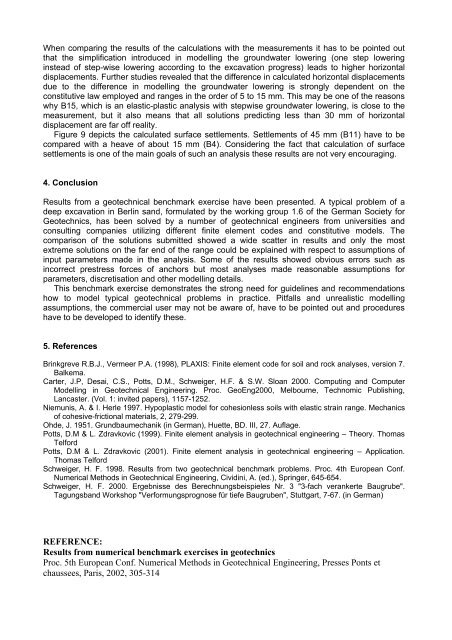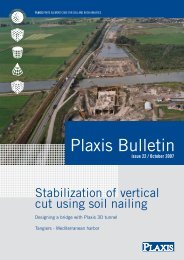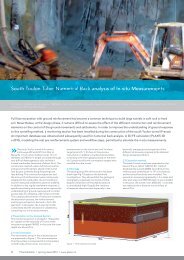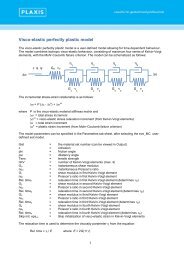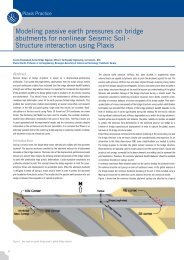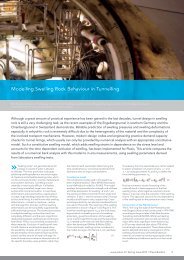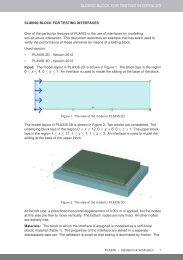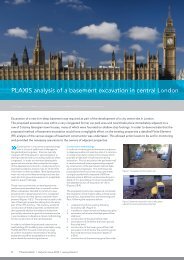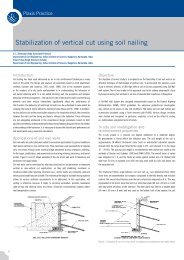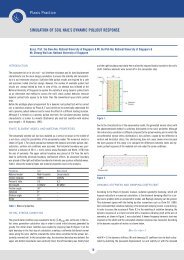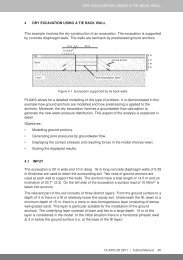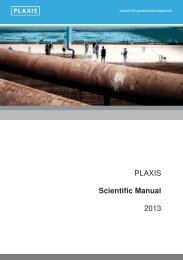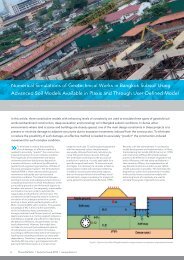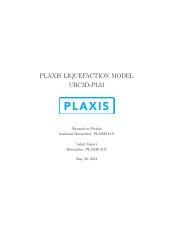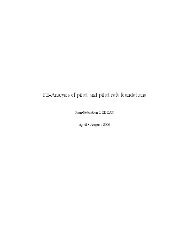Schweiger_ NUMGE_2002.pdf - Plaxis
Schweiger_ NUMGE_2002.pdf - Plaxis
Schweiger_ NUMGE_2002.pdf - Plaxis
You also want an ePaper? Increase the reach of your titles
YUMPU automatically turns print PDFs into web optimized ePapers that Google loves.
When comparing the results of the calculations with the measurements it has to be pointed out<br />
that the simplification introduced in modelling the groundwater lowering (one step lowering<br />
instead of step-wise lowering according to the excavation progress) leads to higher horizontal<br />
displacements. Further studies revealed that the difference in calculated horizontal displacements<br />
due to the difference in modelling the groundwater lowering is strongly dependent on the<br />
constitutive law employed and ranges in the order of 5 to 15 mm. This may be one of the reasons<br />
why B15, which is an elastic-plastic analysis with stepwise groundwater lowering, is close to the<br />
measurement, but it also means that all solutions predicting less than 30 mm of horizontal<br />
displacement are far off reality.<br />
Figure 9 depicts the calculated surface settlements. Settlements of 45 mm (B11) have to be<br />
compared with a heave of about 15 mm (B4). Considering the fact that calculation of surface<br />
settlements is one of the main goals of such an analysis these results are not very encouraging.<br />
4. Conclusion<br />
Results from a geotechnical benchmark exercise have been presented. A typical problem of a<br />
deep excavation in Berlin sand, formulated by the working group 1.6 of the German Society for<br />
Geotechnics, has been solved by a number of geotechnical engineers from universities and<br />
consulting companies utilizing different finite element codes and constitutive models. The<br />
comparison of the solutions submitted showed a wide scatter in results and only the most<br />
extreme solutions on the far end of the range could be explained with respect to assumptions of<br />
input parameters made in the analysis. Some of the results showed obvious errors such as<br />
incorrect prestress forces of anchors but most analyses made reasonable assumptions for<br />
parameters, discretisation and other modelling details.<br />
This benchmark exercise demonstrates the strong need for guidelines and recommendations<br />
how to model typical geotechnical problems in practice. Pitfalls and unrealistic modelling<br />
assumptions, the commercial user may not be aware of, have to be pointed out and procedures<br />
have to be developed to identify these.<br />
5. References<br />
Brinkgreve R.B.J., Vermeer P.A. (1998), PLAXIS: Finite element code for soil and rock analyses, version 7.<br />
Balkema.<br />
Carter, J.P, Desai, C.S., Potts, D.M., <strong>Schweiger</strong>, H.F. & S.W. Sloan 2000. Computing and Computer<br />
Modelling in Geotechnical Engineering. Proc. GeoEng2000, Melbourne, Technomic Publishing,<br />
Lancaster. (Vol. 1: invited papers), 1157-1252.<br />
Niemunis, A. & I. Herle 1997. Hypoplastic model for cohesionless soils with elastic strain range. Mechanics<br />
of cohesive-frictional materials, 2, 279-299.<br />
Ohde, J. 1951. Grundbaumechanik (in German), Huette, BD. III, 27. Auflage.<br />
Potts, D.M & L. Zdravkovic (1999). Finite element analysis in geotechnical engineering – Theory. Thomas<br />
Telford<br />
Potts, D.M & L. Zdravkovic (2001). Finite element analysis in geotechnical engineering – Application.<br />
Thomas Telford<br />
<strong>Schweiger</strong>, H. F. 1998. Results from two geotechnical benchmark problems. Proc. 4th European Conf.<br />
Numerical Methods in Geotechnical Engineering, Cividini, A. (ed.), Springer, 645-654.<br />
<strong>Schweiger</strong>, H. F. 2000. Ergebnisse des Berechnungsbeispieles Nr. 3 "3-fach verankerte Baugrube".<br />
Tagungsband Workshop "Verformungsprognose für tiefe Baugruben", Stuttgart, 7-67. (in German)<br />
REFERENCE:<br />
Results from numerical benchmark exercises in geotechnics<br />
Proc. 5th European Conf. Numerical Methods in Geotechnical Engineering, Presses Ponts et<br />
chaussees, Paris, 2002, 305-314


